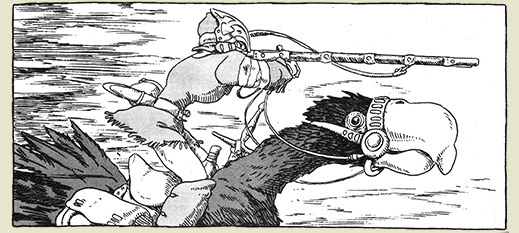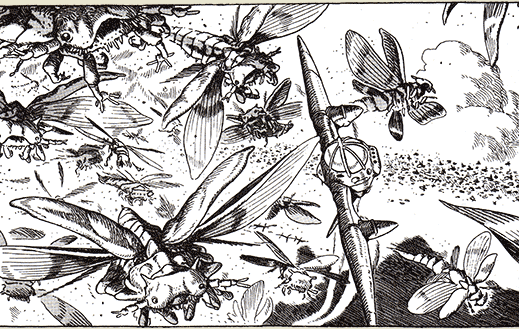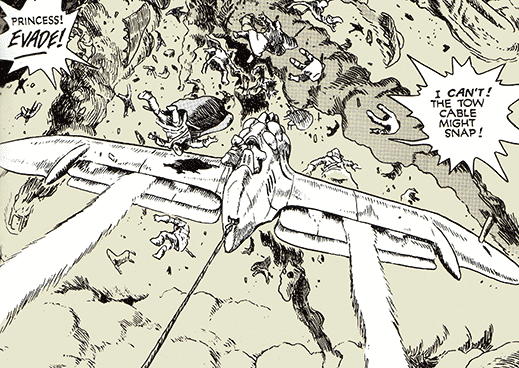Nausicaä of the Valley of Wind
Several years back (this was maybe 2002, right before Spirited Away hit American shores) I was finally able to see Hayao Miyazaki's film Nausicaä of the Valley of Wind. I had heard a lot of good things about it both from friends who adored the bastardized American release fifteen years earlier, Warriors of the Wind, and from friends who regularly sought out Japanese fare. Weeks earlier, I was able to get ahold of a Hong Kong set of all of Miyazaki's works up to that point and was slowly working my way through the collection. When I finally arrived at Nausicaä, I was very excited, having saved the best for last.
Long story short: it sucked. Or at least it did in my mind at the time. The problem was that I was still too much a purist, too much a fan. It's an issue that I've mostly sewn up in a burlap sack for disposal into the nearby lake, but at the time my disappointment in the cinema realization of Nausicaä was tremendous. The source of my complaint was that I had read Miyazaki's manga by the same title. Two works, both named Nausicaä of the Valley of Wind. One was a masterwork, an epic adventure fraught with complex characters, intrigue, and a sense of grandeur; the other was just a movie.

I'm sure that I would have loved the animated film as much as anyone else had I not read Miyazaki's collection of the story in comics form. The problem was that once I had immersed myself so deeply into a sprawling world in which characters were built as if human, with multi-layered motivations, histories, cultures, and customs, the film version almost had to suffer by the comparison. Nausicaä, for many, was an example of Miyazaki's directing and Ghibli's animation style in top form. But for me, fresh from what I considered to be one of the best examples of the comics medium, there was no way for me to see the film as anything but a sad, incomplete replica of what was a staggering work of genius.

Granted, Miyazaki was only one-quarter-finished with the story (in comics form) when he made the animated film version of it, so there's no way it could have the depth of the graphic novel. Granted, it would be impossible to convey even a fraction of Nausicaä's story in a single two-hour film. Granted again, I was an overly-invested simpleton at the time, a purist through-and-through, demanding that film versions of beloved stories be faithful adaptations of their source material. It wasn't a happy way to live, being constantly disappointed by product that didn't hold its source as valuable as I did. Fortunately, I've been healed of my purist tendencies. Maybe I'll one day be able to approach the cinematic Nausicaä with new eyes. But for now, I'm just happy to reread the original.
The story of Nausicaä is robust. It travels a lot of territory and the narrative terrain shifts constantly. The story at page 100 is different from the story at page 200 is different from the story at page 300. Et cetera. Miyazaki keeps the reader off-balance, constantly renegotiating what his story is actually about. In the hands of a lesser author, Nausicaä would seem a confused jumble of ideas, an evolving puzzle its own author could not solve. Fortunately, and I think most of the world probably knows this by now, Miyazaki is among the best storytellers of our age. It shows in Nausicaä. The sureness of his authorial footing in this book is never at doubt. From beginning to end, we are on his ground and it's a good place to be.

Nausicaä tells the story of the post-cataclysmic Earth, a millennium after its destruction by the hands of a weaponized robotic army (presumably created by mankind herself). Humanity has barely survived the nuclear fires that tore civilization apart. The earth itself, polluted beyond its ability to heal in a normal manner, has given birth to a terrible new forest. Called the Sea of Corruption, this roiling swath of strange new flora means death to those that it engulfs, for its air is unbreathable. As land becomes more and more scarce due to this growing threat, wars break out and the future of humanity is threatened all the more. In the midst of this, Nausicaä, a princess of a small outlying tribe, seeks to unravel the mysteries of the Sea of Corruption while negotiating a dangerous path between two warring nations. The princess herself is a mystery to all those she encounters, part chaos, part mercy, and always navigating her own path.
 This scene ends pretty much how you might guess.
This scene ends pretty much how you might guess.
For those familiar with Miyazaki's films, the art will seem a familiar prototype, an early version of what would become the Ghibli house style for the next thirty years. In tone, Nausicaä probably closest resembles the sometimes violent action and environmentalism of Princess Mononoke (though those that weary of that message shouldn't be overly put off by its expression here). The story is long and many panels are more text than imagery as Miyazaki attempts to sensibly exposit his narrative. The tale requires patience and perseverance, but it rewards its pursuers. There are a number of great adventures told through the comics medium, but Nausicaä is so far—and pretty easily—the best of show.
Good Ok Bad features reviews of comics, graphic novels, manga, et cetera using a rare and auspicious three-star rating system. Point systems are notoriously fiddly, so here it's been pared down to three simple possibilities:
3 Stars = Good
2 Stars = Ok
1 Star = Bad
I am Seth T. Hahne and these are my reviews.
Browse Reviews By
Other Features
- Best Books of the Year:
- Top 50 of 2024
- Top 50 of 2023
- Top 100 of 2020-22
- Top 75 of 2019
- Top 50 of 2018
- Top 75 of 2017
- Top 75 of 2016
- Top 75 of 2015
- Top 75 of 2014
- Top 35 of 2013
- Top 25 of 2012
- Top 10 of 2011
- Popular Sections:
- All-Time Top 500
- All the Boardgames I've Played
- All the Anime Series I've Seen
- All the Animated Films I've Seen
- Top 75 by Female Creators
- Kids Recommendations
- What I Read: A Reading Log
- Other Features:
- Bookclub Study Guides










